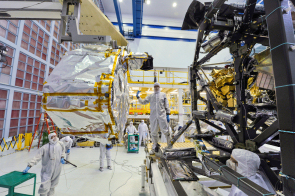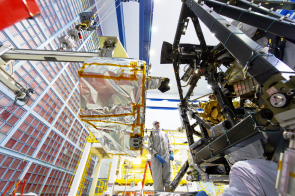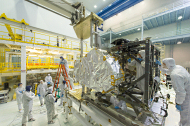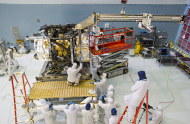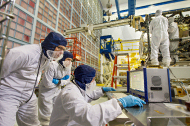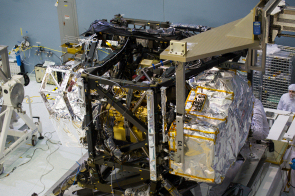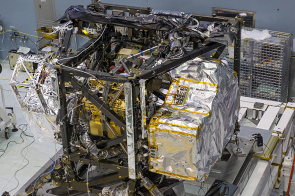#06: NIRSpec dances into place
4 April 2014
An important milestone for the James Webb Space Telescope (JWST) was passed on 25 March with the installation of the Near InfraRed Spectrograph (NIRSpec) on the Integrated Science Instrument Module (ISIM) at NASA's Goddard Space Flight Centre. All four science instruments are now in place on the ISIM, ready for the next series of tests.The installation of NIRSpec was a tricky process - with three instruments already installed on the ISIM the clearances between the other instruments was very small and a lot of care had to be taken to ensure that there was no unintentional contact between surfaces. Technicians from NASA, ESA and Airbus were on hand to visually monitor the clearances to ensure all went smoothly.
The installation process was conducted in two stages: On 24 March 2014 NIRSpec was removed from its mounting frame and installed on the Horizontal Integration Tool (HIT). This tool was first used for preparing hardware for the Hubble Space Telescope servicing missions and it has seen regular service since then. As NIRSpec weighs 196kg, the HIT, which is essentially a big balance beam with moveable counterweights, is ideal for manoeuvring it in the cleanroom. The other science instruments – the Fine Guidance Sensor/Near-InfraRed Imager and Slitless Spectrograph (FGS/NIRISS), the Near-InfraRed Camera (NIRCam) and the Mid-Infrared Instrument (MIRI) were also installed during the past year on ISIM using the HIT.
The second stage was the actual installation into the ISIM. To avoid interference with the other instruments, NIRSpec could not be installed in a straight line but had to be manoeuvred in a special pattern – almost like a dance. The choreography for this activity was devised by NIRSpec's mechanical engineers who worked out the optimum sequence of steps using CAD software. The installation took a little over six hours and ran smoothly.
NIRSpec had to be installed accurately on ISIM. If it was more than 100 microns out (about the thickness of human hair) images might not be in focus or the light paths inside the instruments may be partially obstructed. All of the instruments need to be very accurately aligned with respect to each other and to the JWST telescope (also known as the Optical Telescope Element, or OTE).
The integration of NIRSpec into ISIM is a major milestone for the JWST project, as all of the instruments are now safely installed. ESA and Airbus have been working on NIRSpec for more than 10 years now and the installation marks both an end and a beginning. Being firmly bolted to ISIM symbolizes the start of new activities – including many years of testing still to come. The team behind NIRSpec are very keen to see how well it does in these future tests and, in particular, to see if it achieves the great performances that have been obtained in the earlier test campaigns in Germany.
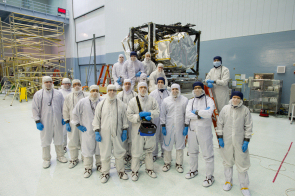 |
 |
| Team photo of people involved in NIRSpec installation on ISIM. Credit: NASA/Chris Gunn | European Team members involved in NIRSpec ISIM integration. Credit: NASA/Chris Gunn |
Now that all four instruments are integrated, the Long System Functional Test campaign can be carried out on the ISIM. This 24/7 test campaign, during which engineers will check and compare the functionality of all the subsystems against previously recorded results, will start in a few weeks from now. This campaign will be followed by an optical metrology campaign to confirm that all instruments are correctly aligned with respect to ISIM.
Later, in July or August, the second set of cryo-vacuum tests will be conducted - this too will be a 24/7 test campaign. A gravity release test (see Journal #5 for a description of this) will then be performed.
Testing of ISIM at Goddard will be completed by the end of 2015. It will then be mated to the OTE and additional testing will follow at Johnson Space Center in Houston. Eventually the observatory will be tested at NGAS (Northrop Grumman) in Redondo Beach, California. Launch of the JWST will be aboard an Ariane V from Kourou in 2018.
About JWST
The James Webb Space Telescope (JWST) will be a general-purpose observatory with a 6.5-m telescope optimised for infrared observations and a suite of 4 astronomical instruments capable of addressing many of the outstanding issues in astronomy. The primary aim is to examine the first light in the Universe - those objects which formed shortly after the Big Bang. Further aims include: looking at how galaxies form; the birth of stars; and the search for protoplanetary systems and the origin of life, including the study of exoplanets. JWST is a joint project of NASA, ESA and the Canadian Space Agency. It is scheduled for launch in 2018 by an Ariane 5 and will operate approximately 1.5 million kilometres from the Earth in an orbit around the second Lagrange point of the Sun-Earth system, L2.
About NIRSpec
The Near InfraRed Spectrograph (NIRSpec) is one of four instruments on JWST. NIRSpec is a multi-object spectrograph capable of observing at least 100 astronomical objects simultaneously. It will support JWST's four main science themes by providing low, medium and high-resolution spectroscopic observations.
NIRSpec is built by European industry to ESA's specifications and managed by the ESA JWST Project at ESTEC, the Netherlands. The prime contractor is Airbus Defence and Space in Ottobrunn, Germany. The NIRSpec detector and MSA subsystems are provided by NASA's Goddard Space Flight Center.

